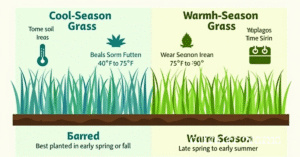A healthy, green lawn begins with knowing when to plant grass seed. Timing plays a crucial role in how well your grass establishes and grows. Plant too early or too late, and your seed may never take root. Whether you’re starting a new lawn or overseeding, this guide will walk you through the best times, seasonal considerations, and expert tips for success.
Why Timing Matters When Planting Grass Seed
Grass seed needs the right soil temperature, moisture, and sunlight to germinate properly. If you plant at the wrong time, you risk poor growth, weed competition, or seed loss.
Different types of grass thrive in different conditions. That’s why understanding cool-season vs. warm-season grasses is the first step.
Best Time to Plant Grass Seed by Type
Here’s a quick breakdown of the ideal planting windows for the two main grass categories:
| Grass Type | Ideal Planting Time | Best Temperature | Common Varieties |
|---|---|---|---|
| Cool-Season Grasses | Late Summer to Early Fall (Aug–Oct) | 60–75°F soil temp | Fescue, Kentucky Bluegrass, Ryegrass |
| Warm-Season Grasses | Late Spring to Early Summer (Apr–Jul) | 65–85°F soil temp | Bermuda, Zoysia, St. Augustine |

Cool-Season Grasses: Plant in Late Summer to Early Fall
For regions with cold winters and moderate summers (like the northern U.S. or Canada), cool-season grasses are the top choice. They germinate quickly in cooler temperatures, especially when soil is still warm from summer but air is cooling.
-
Ideal months: Late August to mid-October
-
Reason: Fewer weeds and diseases, plus enough time before winter frost
-
Tip: Water lightly daily to keep the seedbed moist until sprouting occurs
Warm-Season Grasses: Plant in Late Spring or Early Summer
For southern climates with hot summers and mild winters, warm-season grasses work best. These varieties require higher soil temperatures to germinate.
-
Ideal months: April to early July
-
Reason: The soil is warm, and there’s plenty of sun for strong root development
-
Tip: Avoid planting too early, or seeds may rot in cold soil
Regional Planting Guidelines
-
Northern Zones (e.g., Michigan, New York): Best time is late August to mid-September
-
Transition Zones (e.g., Missouri, Virginia): Spring or early fall for fescue and hybrid blends
-
Southern Zones (e.g., Texas, Florida): Best time is late April to early June
Steps to Take Before Planting Grass Seed
-
Test Your Soil – Ensure pH is between 6.0 and 7.5
-
Clear Debris – Remove rocks, weeds, and old grass
-
Loosen Soil – Use a rake or aerator for proper seed-to-soil contact
-
Apply Starter Fertilizer – Gives new grass a boost of nutrients
-
Evenly Spread the Seed – Use a broadcast spreader for consistency

Aftercare: What to Do After Planting
-
Water Lightly and Frequently – 1–2 times daily for the first 2 weeks
-
Avoid Mowing – Wait until grass reaches 3 inches in height
-
Limit Foot Traffic – Allow seeds to take root undisturbed
-
Fertilize Again After 4–6 Weeks – Use a high-nitrogen lawn food
Common Mistakes to Avoid
-
Planting too early or too late
-
Using the wrong seed for your climate
-
Overseeding without aeration
-
Skipping starter fertilizer
-
Letting soil dry out during germination

Conclusion
Knowing when to plant grass seed is the difference between a patchy lawn and a lush green oasis. Whether you’re laying down warm-season or cool-season seed, the right timing ensures your grass gets off to a healthy start. Plan according to your region, follow best practices, and you’ll enjoy a lawn that thrives season after season.
Frequently Asked Questions (FAQs)
Can you plant grass seed in summer?
Yes, but it’s not ideal. Hot temperatures and dry soil can stress seedlings. If you must plant, water frequently and choose heat-tolerant varieties.
What temperature is too cold to plant grass seed?
If soil temps are below 50°F, seed germination will be very slow or fail entirely. Use a soil thermometer for accuracy.
How long does it take for grass seed to grow?
Most grass seed germinates in 5–21 days depending on type, weather, and care. Full lawn establishment may take 6–10 weeks.
Can I just throw grass seed down on existing lawn?
It’s not recommended. For better results, mow low, aerate, and ensure seed-to-soil contact before overseeding.
How often should I water new grass seed?
Keep the soil consistently moist with light watering 1–2 times a day for the first 2–3 weeks.






